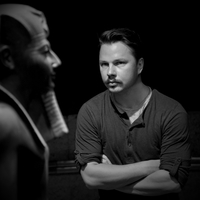Papers by Slawomir Rzepka
Antiquity, Mar 8, 2024
Excavations at the site of Tell el-Retaba since 2007 have revealed an extensive settlement and as... more Excavations at the site of Tell el-Retaba since 2007 have revealed an extensive settlement and associated material culture dating from the Third Intermediate Period (1070-664 BC). This work represents the only largescale investigation into domestic archaeology from this period in Egypt and the results offer important insights into aspects of urban life for an under-studied phase of Egyptian history.
Ägypten und Levante, 2016
Polish Archaeology in the Mediterranean, 2016
The sixth season of fieldwork of the Tell el-Retaba Archaeological Mission has brought a number o... more The sixth season of fieldwork of the Tell el-Retaba Archaeological Mission has brought a number of significant results. For the first time remains of a Hyksos settlement (beside the previously known cemetery) were uncovered. Exploration of a large, regularly planned building, divided into a number of standardized flats, brought new evidence for the reconstruction of the function and organization of a strongly fortified town, which existed on the site during the Twentieth Dynasty. Remains of a Third Intermediate Period settlement showed that after the New Kingdom there was a clear change in the settlement pattern in Tell el-Retaba.
Polish Archaeology in the Mediterranean, 2017
The excavation at Tell el-Retaba in 2014 and 2015 comprised three seasons of fieldwork, carried o... more The excavation at Tell el-Retaba in 2014 and 2015 comprised three seasons of fieldwork, carried out in sectors of the site already opened in previous years. The earliest archaeological remains date from the Second Intermediate Period and represent a Hyksos settlement and cemetery. Ruins of an early Eighteenth Dynasty settlement, fortresses from the Nineteenth and Twentieth Dynasties and from the Third Intermediate Period settlement continued to be excavated as well. Of note are some archaeological remains from the 17th–19th centuries, presented for the first time in the fieldwork report.
Antiquity, 2024
Excavations at the site of Tell el-Retaba since 2007 have revealed an extensive settlement and as... more Excavations at the site of Tell el-Retaba since 2007 have revealed an extensive settlement and associated material culture dating from the Third Intermediate Period (1070-664 BC). This work represents the only largescale investigation into domestic archaeology from this period in Egypt and the results offer important insights into aspects of urban life for an under-studied phase of Egyptian history.
Polish Archaeology in the Mediterranean
In 2019, the Polish–Slovak Archaeological Mission in Tell el-Retaba continued the excavation of a... more In 2019, the Polish–Slovak Archaeological Mission in Tell el-Retaba continued the excavation of a Third Intermediate Period settlement in Area 9. The paper presents two houses, {1095} and {3111}, in detail. Activity-area analysis is employed to determine the main occupations of the inhabitants in successive phases. The analysis is based on the archaeological assemblage recorded from these features, including small finds, pottery, and installations.

The Tell el-Retaba Archaeological Project aims at exploring one of the major Dynastic-period site... more The Tell el-Retaba Archaeological Project aims at exploring one of the major Dynastic-period sites in Wadi Toumilat in the Nile Delta. Sitting on a strategic crossroads of the main route from Egypt to Syro-Palestine, Tell el-Retaba must have played an important role in the region at least during New Kingdom times (Morris 2005: 504–508). Previous archaeological work on the site — excavations by E. Naville (1887), W.M.F. Petrie (Petrie, Duncan 1906: 28ff.) and H. Goedicke (unpublished, see http://users.stlcc.edu/mfuller/Retaba), as well as surveys by a german team (Neuffer et alii 1932: 44) and a Canadian one (Redmount 1989: 125ff.) — has provided ample evidence in support of this view. However, practically nothing is known of the earlier history of the site and apparently there had been a settlement there quite early on. The objective is thus to reconstruct the history of the settlement in Tell el-Retaba from the earliest times until its abandonment. During the first season at the site the team aimed at evaluating the condition of the site and identifying major threats to its preservation, locating structures excavated by Petrie at the beginning of the 20th century, and verifying and supplementing his documentation, for example, by tracing the northern defense wall. Methods included mapping, fieldwalking and geophysical survey. The first field season took place between 12 and 30 April 2007
Ägypten und Levante, 2017
The preliminary report discusses Areas 4, 7 and 9, situated in the western and southern parts of ... more The preliminary report discusses Areas 4, 7 and 9, situated in the western and southern parts of the tell, where 21 occupancy phases (A-G3) KDYH EHHQ LGHQWL¿HG VR IDU 7KUHH VWUXFWXUHV RI DQ open settlement were unearthed which date to the SIP phase G3. The excavations corroborate the continuity of the SIP settlement to the early 18 th Dynasty. Some 19 th Dynasty structures were still in use during the 20 th Dynasty; the architects of the 20 th Dynasty fortress had to take them into consideration. In Area 9 houses of the Third Intermediate Period were uncovered, as well as buildings (including a "tower house") of the Late Period settlement.
Ägypten und Levante, 2020
One of the current projects of the Polish- Slovak Archaeological Mission in Tell el-Retaba is the... more One of the current projects of the Polish- Slovak Archaeological Mission in Tell el-Retaba is the exploration of a large area of the Third Intermediate Period settlement. During the 2017 season several houses belonging to this settlement were partly excavated. House {2147}, in which several phases of occupation could be distinguished, was particularly interesting. This house yielded an unusually rich set of small finds, including a bronze forked butt of a spear, and a set of lead fishing-net sinkers
Polish Archaeology in the Mediterranean, 2018
Excavations of the Polish–Slovak Archaeological Mission in Tell el-Retaba in 2016 were continued ... more Excavations of the Polish–Slovak Archaeological Mission in Tell el-Retaba in 2016 were continued in the western part of the site, uncovering remains of domestic and funerary structures from the Second Intermediate Period in Area 4. Houses from the first half of the Eighteenth Dynasty were also investigated in this area. In Area 9, several houses from the Third Intermediate Period were explored and, for the first time, also substantial remains of a Late Period settlement, including at least one “tower house”.

Studia Quaternaria, 2016
The archaeological site Tell el-Retaba in north-eastern Egypt, about 35 km to the west of Ismaili... more The archaeological site Tell el-Retaba in north-eastern Egypt, about 35 km to the west of Ismailia city, is located in the middle of Wadi Tumilat, a shallow valley running from the Nile Delta to the Bitter Lakes, along which flows the Suez Canal. In ancient times the valley was a route between Egypt and Syro-Palestine, strongly fortified in the New Kingdom times (16th–11th century BC). Mud bricks were analyzed from two parts of the Wall 1 (core of grey-brown bricks and inner extension of green bricks) in a fortress which existed during the Ramesses II times. Grain-size composition of the studied bricks was almost identical in both parts of the wall, suggesting the same source material for a production of brick. However, significant differences were observed in physical and mechanical properties (uni-axial compressive strength) in both types of bricks. Bricks from the core had lower bulk density, higher porosity and soak faster, whereas their resistance parameters were much lower tha...

Studia Quaternaria, 2017
The Tell el-Retaba archaeological site is located at Wadi Tumilat, a shallow valley running from ... more The Tell el-Retaba archaeological site is located at Wadi Tumilat, a shallow valley running from the Nile Delta to the Bitter Lakes. In ancient times, a route connecting Egypt with Syria-Palestine ran across the site. In the 13th century BC, during the rule of Ramesses II, a fortress surrounded by “Wall 1” was erected and in times of Ramesses III in the 12th century BC, a larger fortress surrounded by “Wall 2” and “Wall 3” was constructed. Using the finite element method (FEM) and ZSoil 2D&3D software, the wall heights were modelled and their soil-structure interaction was analysed. Strength of the wall depended on size and strength of bricks and mortar, brickwork, wall shape and foundation. Ancient builders using mud bricks must have known from practical experience the essentials of a wall construction, in which the height to width ratio was at 1.75 to 1.85. Moreover, they must have related the engineering properties of the material with the height of the construction and its purpo...
Gottinger Miszellen Beitrage Zur Agyptologischen Diskussion, 1998
Senenmut, qui avait supervise les travaux du temple d'Hatchepsout a Deir el-Bahari, s'eta... more Senenmut, qui avait supervise les travaux du temple d'Hatchepsout a Deir el-Bahari, s'etait fait representer derriere pratiquement toutes les portes des chapelles et des niches, et ceci de telle maniere que ces gravures ne fussent pas visibles pendant les ceremonies. Certains erudits estiment que ces reliefs etaient un secret entre Senenmut lui-meme et les sculpteurs qui les avaient executes. Des representations cachees analogues se trouvent deja dans les mastabas de l'Ancien Empire, ce que l'auteur presente ici.
Mitteilungen Des Deutschen Archaologischen Instituts Abteilung Kairo, 2004
The article presents two graffiti of a I7 t h Dynasty king, Nubkheperre Intef, found in Deir el-B... more The article presents two graffiti of a I7 t h Dynasty king, Nubkheperre Intef, found in Deir el-Bahari near to the tomb DB 320 ('royal cache'). They yield some new arguments in a discussion on the date of the 'royal cache' and the identity of its original owner, as well as some new indices for the reconstruction of the history of the I7 t h Dynasty.
Studien Zur Altagyptischen Kultur, 1996
This article is an attempt to reinterpret a rather obscure category of monuments the so-called ps... more This article is an attempt to reinterpret a rather obscure category of monuments the so-called pseudo groups. One royal and a few dozens of private pseudogroups dated for V and VI dynasty are known. They were interpreted very differently by various scholars who dealt with them. The discussion of so far proposed theories is followed by a new interpretation. Its essential ideas are: 1) the statue of the deceased is a body in which his ki lives and takes offerings; 2) a noticeable feature of the ki is its heredity; 3) one of the principles of egyptian logic is complexity of unity and multiplicity. The result of these assumptions is the interpretation of pseudogroups as a kind of specific family groups.
Archiv Orientalni Supplementa, 2000
The group statue of Akhi (Cairo Museum CG 44) is discussed in the context of some other comparabl... more The group statue of Akhi (Cairo Museum CG 44) is discussed in the context of some other comparable sculptures. It is shown that shortly after its completion the statue was altered. It dates from the mid-Fourth Dynasty.











Uploads
Papers by Slawomir Rzepka
The focus is on Ancient Egyptian examples, but non-textual marking systems like pot marks, mason’s marks, brick marks and other identity marks are known from many cultures and periods from Prehistoric to modern times. The broad variability of use and function of these marking systems which occur irrespectively of whether or not the particular community has a script is illustrated by case studies and by a close comparison of material originating from different time periods and from various places in Egypt and elsewhere.
to order:
http://www.widmaier-verlag.de/index.php?content=issue&isbn=978-3-943955-16-3
- Is there a simple relation between place of work of the gang and the localization of the workmen’s graffiti (that is, are graffiti from a given period concentrated clearly within range of the tombs being cut at the time or on the way to it)?
- Did status in the community determine the needs/opportunities of individual members to visit different parts of the necropolis (for example, did scribes visit the same parts of the necropolis as foremen and foremen the same areas as ordinary workmen or sculptors)?
- Was status in the community reflected in the localization of graffiti (for example, did foremen and scribes leave their inscriptions in the same places as ordinary workmen)?
- Whom were the graffiti addressed to? Were they concentrated in attended areas and were made to be seen from afar or not?
***
The monograph is divided into five parts. The first one presents the methodology underlying the compilation of the corpus of graffiti examined in this study. Issues connected with distinguishing single graffiti and identification of the authors are discussed, followed by a presentation of topographic and chronological divisions used as a framework for the analysis of the material collected in the corpus.
The second part is concentrated on who were the authors of rock graffiti. Who of the known members of the Deir el-Medina community left their graffiti? What was their status in the workmen’s community and what duties did they fulfill? What conclusions can be drawn on the functioning of this community from the observation that certain members of the group carved rock inscriptions, while others seldom or not at all? This part also contained a chapter on "accompanying" persons in the graffiti. Who were the people whose names graffiti authors mentioned in their inscriptions? What were the ties between the authors and their "peers"? One of the subchapters deals with the issue of family traditions and whether they had an influence on whether someone left graffiti or not. Family trees of clans present in the Deir el-Medina community for generations show the men who left graffiti.
A separate section in this chapter was devoted to a collocation analysis. Statistical analyses have made it possible to identify pairs of authors who left graffiti in the same places and so presumably walked in the Theban gebel together. It was also possible to recognize pairs of authors who "avoided" one another or at least never left their graffiti in the same places.
In the third part, the issue of "where" was addressed. All the dated graffiti in the corpus were mapped, giving a good idea of which parts of the Theban gebel were visited more or less frequently in particular periods. Of particular interest is recognition of places where the presence of Deir el-Medina workmen was not obvious, that is, places not in the immediate vicinity of tombs made by them or paths that led to these tombs. Identification of places of this kind led to certain hypotheses on the organization of the logistically complex process of preparing tombs for kings and members of their families.
The results of parts two and three serve as the basis for an exploration in part four of the question of why these rock graffiti were made in the first place. What was the purpose and meaning of the inscriptions left by members of the Deir el-Medina community in the Theban massif. Were they important to their authors or just made "by the way"? Were they oriented to the author or the audience, that is, was it the author who benefitted or the people reading the inscription, or both? Were they practical (in our modern understanding of the term)? Did they carry information useful for the author or audience in earthly life or were they oriented to the realities of the afterlife, that is, benefitting the author after death?
The fifth part of the study is made up of the catalogue, which is the basis of all the analyses presented in parts from one to four. It is a dossier of all the graffiti in the Theban gebel that can be identified with concrete members of the Deir el-Medina community. The 177 authors that were identified left over 1800 graffiti, making for an extensive corpus, which for practical reasons was limited in hard copy to a dozen or so of the most active graffiti authors in particular periods. A complete catalogue in digital form can be found on an attached disc. The catalogue follows a chronological order. Items consist of all the graffiti of a given author, in topographical order, together with maps documenting the exact localization of all the graffiti.